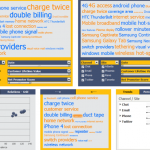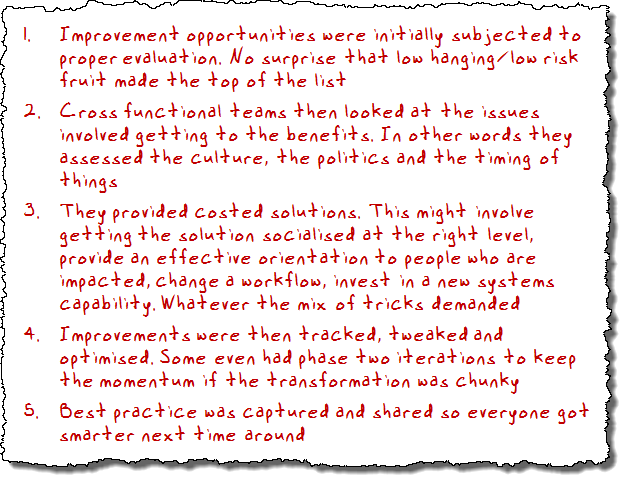
Call centres, or contact centres if you prefer, have been forced onto the back foot during most of their relatively short history.
They have fallen into the trap of ‘inheriting the sins of the organisation’ without the ability to robustly prove that the source of an issue lies elsewhere. Thus call centres remain cost centres rather than strategic assets. Prey to off-shoring, automation and anything else that reduces the apparent cost to serve. Even at the expense of the customer experience and that of the advisor community.
At least that is the heritage from which the industry is trying to recover.
Customer Services Should Aspire To Strategic Status
When I’m discussing Next Generation Customer Service with leadership teams, I often tell them the following story to illustrate where they ideally want to be positioned within their organisation’s network of influence.
“…Imagine how the enlightened boss of the future sets themselves up to win as they arrive in their new post as CEO. They make a bee-line for the person running Customer Service and do a deal. In return for financing a customer interaction analytics solution, the CEO gets to have a live dashboard on their office desk…”
Why is that a smart move?
This CEO knows that between the choice of being presented with internally orientated reports, carefully manicured for executive presentation and a live feed of the customers’ voice, she knows which one will give her the better view of issues and priorities. Thus Customer Services becomes elevated to a position of strategic importance.
Of course they are many barriers standing in the way of that becoming commonplace. How many CEOs get both the value of real time insight and know about the power of customer interaction analytics? Not many I would guess at this point in time. But let’s hope that all the C-suite hype around Big Data and the notion of ‘faster than real time‘ will provide the motivation to learn more about this all important branch of analytics.
It’s A Question Of Mindset
The other main barrier comes from Customer Service leadership teams. Decades of operational fire fighting have left them blind to anything outside the habit of running things via the rear view mirror.
My cartoon version of this culture is to define a ‘good day’ for these type of folk as one in which most of the scheduled ‘bums on seats’ actually appear on the day, the technology doesn’t have a seizure and the best friend of the chairman’s wife has not just suffered a service experience that provokes her to pull rank.
If none of that happens by the end of the shift then a ‘good day’ has just been experienced.
In other words, the current generation of leadership teams have neither headroom nor motivation to defy the gravitational pull of events that has put them on the back foot for so long. It seems beyond them to use customer insight to change the function and value that their Customer Service organisation can offer to both external and internal customers.
I know I’ve exaggerated my description and that there are organisations that are learning to rebalance onto the front foot. But from the UK perspective, it remains personally frustrating just how slow this transition is taking.
Is the rest of the world much different?
Why Analytics Is A Game Changer
Analytics is big. Just Google it and most organisational functions can now choose their own flavour. Within the next decade, I’m sure many organisations will have brought these together into some overall context of ‘business analytics’. But for now it’s best to be specific. So, within the spectrum of Customer Analytics, (a subset of Business Analytics), Interaction Analytics is what Customer Services needs to focus on.
 Even within that slice, we are still looking at an evolving market. There are vendors who have specialised in speech. Others who focus on making sense of text based interactions. More recently social analytics (aka social media monitoring) has become more visible to Customer Service teams.
Even within that slice, we are still looking at an evolving market. There are vendors who have specialised in speech. Others who focus on making sense of text based interactions. More recently social analytics (aka social media monitoring) has become more visible to Customer Service teams.
Whatever the version or the vendor, the impact of analytics on a ‘first time’ organisation puts clear blue water between it and those without any headlights. To my mind it’s the story of the Pony Express versus the Telegraph all over again: simply transformative in terms of its potential.
I should of course add that potential and realised benefits are different and not inevitably linked. But that is an issue of timing, circumstance and the ‘right’ leadership. Not that the old way of doing things is now anything other than redundant.
Making It Happen Needs Method
However the ability to listen and then sift through the haystack is only the start of the journey. Maybe that is why we so often hear the term ‘actionable insight’. Sounds great, but how many teams have actually operationalised that capability?
A few decades back, the quality movement turned up big time to drive down failure demand in organisation that made stuff. (Yes I know there was a time when we still did that stuff on-shore!). What I liked was the completeness of their approach.
That description might be slightly rose tinted, but I personally witnessed a few and it remains a surprise that the service sector has been so slow to copy that success. By the way before you make the point, six sigma black belts are only one type of team member needed to make this happen!
Why A Voice Of The Customer Program Gives Focus
While it can be useful to look back for inspiration, we also need to recognise that the world today has moved on. One key characteristic is the sheer volume and diversity of customer feedback. At almost every point in any interaction or transaction cycle, brands now ask us for our opinion or experience.
But how is that used to generate insight? It’s still an outstanding issue. Put the unsolicited volume of ‘social chatter’ on top of that and many feel they are drowning.
I’m a big fan of Voice of The Customer (VoC) initiatives. For the recently promoted SVP of Customer Experience, they provide a welcome and practical first milestone to get their teeth into. By the way if your organisation doesn’t invest in such roles, VoCs can be sponsored directly by Customer Services.
Equally you might find that the ownership issue of social customer service between Marketing, PR and Customer Services provokes a broader debate about collaboration using the rich mix of customer insight that social channels throws up. A VoC can provide both focus and organisation to these customer facing teams when looking for new ‘post-silo’ models of working together.
Whatever the motivation, VoCs are groovy! They encourage cross functional sharing. They are inclusive of data sources and recognise this is a strength once organised. Personally I always recommend a diversity of sources for customer feedback in order to generate a broader and more realistic perspective.
For instance how does customer insight vary by channel? ‘Voice’ customers and ‘social’ customers can come across very different. What does that reveal? Personally I’m always more convinced about the validity of insights when issues show up consistently on more than one media. Is your own experience different?
Reducing Failure Demand Is Great. Innovation Is Even More Valuable
Assuming you invest in an interaction analytics capability, then this is the route by which Customer Service can ascend the greasy pole of corporate hierarchy into the ‘Strategic Club’.
How so?
At the top of this post, I said that Customer Services had inherited the ‘sins of the rest of the organisation’. By which I meant they were unable to ‘prove’ their root cause analysis around failure demand. Well-run analytics enables that. Numbers talk and others have to listen at the very least.
However failure demand and overall Customer Service productivity/effectiveness is only part of the value. The other thread of gold that should be searched for is innovation. What are customers telling us about their needs and thus untapped opportunity? And I’m not just talking about the next killer product they are indirectly hinting at.
Think about the typical sales process in B2B. In today’s world, prospects will have completed 70% of the sales cycle via online search, WOM and recommendation before needing to directly interact.
That puts a radical spin on what value the fully loaded costs of a field sales force can now deliver. I don’t pretend to know the answer to that. However if I were an SVP of Sales and received regular analysis from the VoC team on this evolving behaviour, I would no doubt become indebted to them helping me evolve my next generation sales strategy.
Parting Thoughts
There is a second part to that story of the smart CEO.
After a few executive sessions, in which departmental reports are reduced to one minute verbal updates in favour of lengthy debate around what the customer insight dashboards are throwing up, our wily CEO ups the stakes.
She introduces the cross charging ‘game’. If the source of an issue that Customer Service deals with comes from another team, then they get charged for causing it!
For instance who owns the cost of educating customers in how to use the product? Marketing, Manufacturing, R&D? Maybe even L&D. Let the debate begin!
I guess you can imagine how those with functional based incentives then react when they get charged. In theory, running Customer Service becomes close to a zero cost operation. Failure demand is now actioned at source.
There is much ongoing debate as to what a customer centric organisation really looks like. For my money, I’ve just described how it sets out on that journey in a radical fashion.




